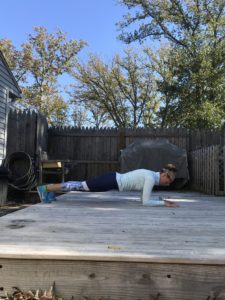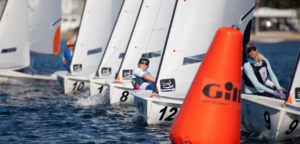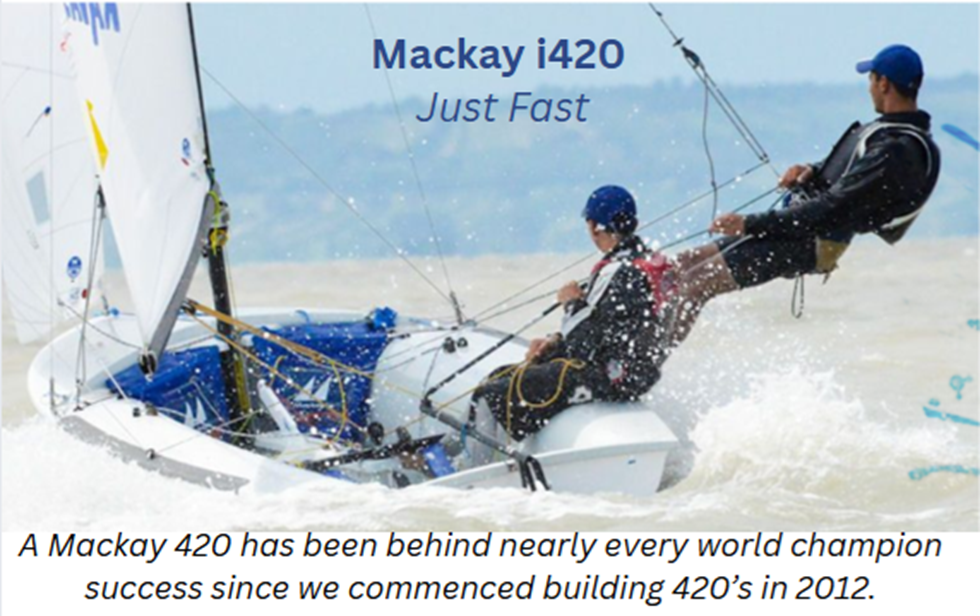NewsFlash: The Lake George Club has an opening this summer for a Waterfront Director/Head Sailing Instructor
The Lake George Club was formally organized and received its certificate of incorporation on November 16, 1908. Nine months later a clubhouse had been built and docks, tennis courts and a nine hole golf course were in place.
The Club opened its doors on August 14th, 1909 with its first and only Superintendent, Mr. Emil Strand and his bride, to welcome the members. Mr. Strand served the members for fifty-four years until he retired in 1963. Each spring he grew the white petunias which graced the Clubhouse. We keep this tradition as a tribute to his long and dedicated service.
The purpose of the Club as outlined in a meeting in 1908 was to provide a place where residents and visitors might meet and have the opportunities for mutual pleasure, to hold regattas and other aquatic sports, to provide a golf course, tennis courts and facilities for other games and make arrangements for dramatic and musical entertainment.
These things were all done, but changes have taken place over the years. The original regattas were motor boat races. Ever faster and more sophisticated boats were built and raced, leading at last to George Reis’ El Lagarto which won the Gold Cup in 1933 and defended the Cup in 1934 and 1935 at the Lake George Club. That was the last Club sponsored motorboat regatta.
Golf was played on a nine-hole course laid out on Club property and property to the north leased from the Marion House. The course ran parallel to and on both sides of the Bolton Road. The Marion House was torn down in 1939 and the land subdivided, but the golf course continued in operation through 1942 when the lease expired.
The original three clay tennis courts served the members for 75 years. For thirty-three of those years, 1916-1949, the Tennis Chair was Miss Helen Simpson, a devoted member who was also a director for twenty-eight years and Vice President for five years. In 1983-84, after ten years of discussion, three new courts were added and the old courts resurfaced. We continue to have some of the finest courts in the area.
Sailing was introduced in 1935 with boats from all over the lake invited to join the eight Club boats; Dr E.F.W. Alexandersons Nordic, Mr. W.M. Bowdens Highland Fling, three Stars and three Cape Cod Knockabouts. The Stars began racing as a separate class in 1936 followed by the Cape Cods in 1937 and the Sound Interclubs in the late thirties. Mr. Harold Pitcairn, who was Commodore from 1940 to 1953, provided his own fleet of two boats in each class sailed by himself and his eight children. Sailboat racing was suspended from 1943 through 1945. New classes were introduced after the war: the Rainbows in 1963, the J-24’s in 1980 and the J-22’s in 1991. The sailing story would not be complete without the mention of Ralph and Mary Derby, Boom Boom and Can Can, who were in charge of the starting guns and signal flags on the race committee boat for over 25 years.
Learn more about our junior sailing program HERE.
During World War II, the membership dropped from 125 to 64. The Club was closed for the 1943 season. A small group headed by C. Everett Bacon, president from 1933-1945, and Hubert Brown, 1946-1947, rallied support and contributions to keep things going. In 1955, the emphasis shifted from the older generation to the baby-boomers.
Tennis, sailing and swimming instructors were hired in 1955 and junior tennis and sailing programs were started. The juniors competed in Turnabouts, Cape Cods and Lasers for the next 25 years. Contributions from the members have permitted the Club to fund three newer fleets: the 420’s in 1979, the Optimist Dinghies in 1990, and the FJ’s in 1994. The children of the baby-boomers are now active participants in our junior programs.
The club presently has 300 regular members and a waiting list of prospective members. The House Committee and staff have revitalized our Social program. Sailing and tennis are actively pursued on all levels.
The Junior Sailing program is a focus of the Club. Juniors grow up sailing, swimming and playing tennis, building long lasting relationships. Their parents and parents did as well. There is a great sense of community and family here! Learn more about the Junior Sailing Program here: http://www.thelakegeorgeclub.com/Summer-Sports/sailing.html
NewsFlash: The Lake George Club has an opening this summer for a Waterfront Director/Head Sailing Instructor
For more information, please contact:
Tracey Thacker / 518-668-5734 / lgctracey @ yahoo.com
Blog
2017 J/24 East Coast Championship Report & Results
It was another fantastic Fall weekend of racing in Annapolis for the 39th J-24 ECC & J/22 Mid Atlantics. Twenty-four J/24 teams raced Friday through Sunday, joined by twenty-five J/22 teams on Saturday & Sunday. Full results HERE
Things started on the right foot, with teams arriving to the luxury of Gold Sponsor, The Rigging Company ( https://theriggingco.com/ ), helping with mast stepping and setup. J/24 Fleet 8 members provided free housing to many out of town teams and can accommodate many more in the future.
We’ll get to the action on the water in a moment – the highlight on land was the Saturday evening dinner & dance party under the tent! When sailors came off the water, the beer truck was their first stop, then on to the racing recap organized by North Sails Mike Marshall. Mike brought together a cohort of world class sailors, including Allan Terhune, Willem van Waay, Cory Sertl & Matt Schubert. The breeze was in the mid-teens all day so the focus was on rig settings, steering in waves, and determining how to pick the favored side. Starting at 1800, over 180 J sailors broke bread, with a wonderful meal catered by Annapolis Smokehouse. Shortly afterward, The Shatners, an uber-popular Annapolis band got going, as did the flip-cup challenge between the 24’s & 22’s. The crowd, packed onto the dance floor, demanded two encores of the band before they finally allowed them to leave the stage!
On Friday night, Travis Odenbach from Quantum Sails led a recap of the Friday racing, featuring pearls of wisdom from professional sailor Willem van Waay, Mike Coe from Quantum, and Even Petley-Jones from Halifax, NS. In addition to discussing rig settings & depowering techniques, Willem van Waay gave the crowd an advanced course on using the ProStart! Meanwhile, Lyon distilling was mixing their special rum into Dark & Stormys, and the crowd was enjoying oyster shooters & two hot soup offerings.
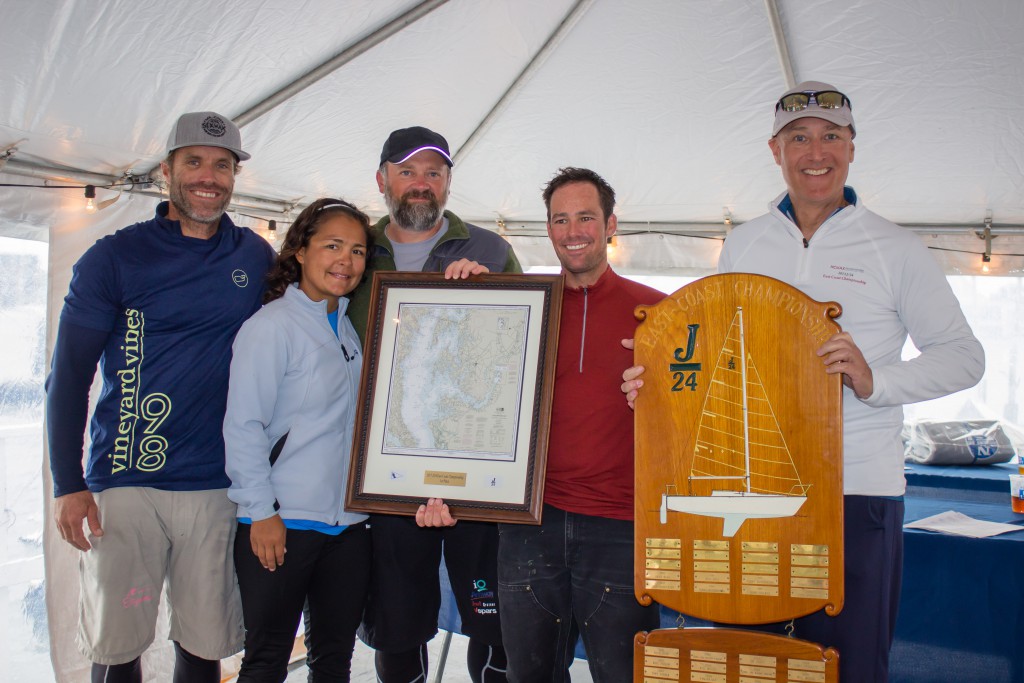
Friday Photos:
https://lukepelican.smugmug.com/J24-East-Coast-Championship-Day-1/
Saturday Photos:
https://lukepelican.smugmug.com/J24-ECC-Day-2–J22-Mid-Atlantic-Day-1/
Featured Photos:
http://j24eastcoastchampionship.com/?page_id=19
No Equipment? No Problem! : Workout For Anywhere Anytime
Getting a good workout in doesn’t have to be complicated. You can get a great workout 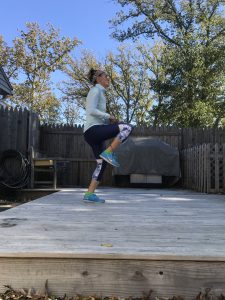
In the workout below you will get a full body workout with cardio mixed in. This is a fun workout you can do anywhere anytime! Next time you’re on the road or don’t have time to make it to the gym add this workout in to help better your sailing performance on the water. Remember working out for sailing doesn’t have to be complicated!
No Equipment Workout:
-Warm up with Dynamic Stretching (5 minutes)
Core Activation:
-Plank Jacks (30 seconds)
-Split Lunges (30 seconds)
-Shoulder Taps (30 seconds)
-High Knees (30 seconds)
Repeat 3x
The Workout:
1. Push Ups (15 reps)
2. Wall Sit (60 seconds)
3. Shoulder Taps (20 reps)
4. Forward Alternating Lunges (20 reps)
Repeat 3x
1. Burpees (30 seconds)
2. Switch Kicks (30 seconds)
3. Mountain Climbers (30 seconds)
Repeat 2x
1. Tricep Dip w/ Leg Raise (15 reps)
2. Single Leg Deadlift (15 reps each side)
3. Rotational Push Up (12 reps)
4. Squat Pulses (30 seconds)
Repeat 3x
1. Plank (60 seconds)
2. Diamond Push Up (12 reps)
3. Side Plank Knee To Elbow (12 reps each side)
4. Squat Jacks (20 reps)
Repeat 3x
1. Tuck Jumps (30 seconds)
2. Wide Mountain Climbers (30 seconds)
3. Squat Jumps (30 seconds)
Repeat 2x
-Cool Down with Foam Rolling and Static Stretching (5-7 minutes)
For more information on fitness for sailing contact [email protected]. Also check out Sailorcise on Facebook, Twitter, and Instagram for daily tips on fitness, nutrition, and sailing.
ICSA News: #12 George Washington wins the Mid Atlantic; #3 Charleston win the Hoyt and #2 Coast Guard win Mrs. Hurst
#12 George Washington University won the MAISA Women’s Fall Dinghy Championship, hosted by SUNY Maritime College. The regatta, on the shores of the East River, was dictated by the breeze, or lack thereof. The 8 race event, therefor was a stressful one for MAISA teams hopeful of a berth to the Women’s Atlantic Coast Championships with only 7 available.
The Colonials of GWU were impressive, finishing in the top-3 in each of the two divisions, including a B-Division victory by Riley Legault ‘19 and Andreea Rainey-Pace ‘20 with 11 total points after 4 races sailed.
Senior, Rose Edwards of Georgetown with Caroline Teare ‘21 won A-Division with just 7 points after the 4 races sailed. The Hoya boat finished with no races outside the top-2.
The seven teams to qualify for the Women’s Atlantic Coast Championship, held at Connecticut College, November 11-12, are #12 George Washington, #14 Hobart and William Smith Colleges, #16 Cornell, #9 Georgetown, Fordham, #20 Navy and #17 St. Mary’s.
The Sherman Hoyt Trophy hosted by Brown University was the premier Coed-Inter-conference regatta hosted over last weekend. Moreover, it was the only major interference or conference championship with quality breeze throughout the weekend. After 14 races sailed in each of the two divisions, #3 College of Charleston won the event by 10 points over #2 Yale.
The only team with two top-5 division scores, the Cougars placed 3rd in A and 3rd in B which was enough to get it done for Charleston in a regatta where consistency was hard to find. Charleston featured their stalwart team of Stefano Peschiera ‘18 with Grace McCarthy ‘18 in A and Augie Dale ‘19 and Katherine Lounsbury ‘20 in B.
#6 Dartmouth College Juniors, Christopher Williford and Rebecca McElvain won A-Division with 75 points. Stringing together a scoreline with only two races outside the top-10, the Big Green Boat was impressive.
Lindsey Baab ‘18 and Julia Kim ‘18 of #20 Brown won the B-Division with 77 points, winning four of the 14 races sailed.
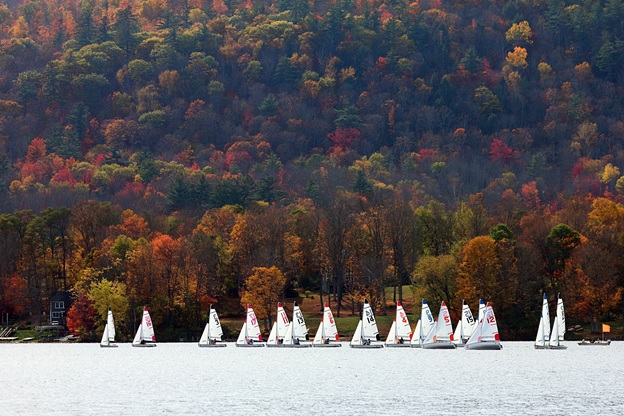
Ragna Agerup ‘20 and Abigayle Konys ‘19 of #3 Brown won A-Division with 21 points and Dartmouth’s Audrey Giblin ‘20 and Sophia Diserio ‘18 won B-Division with 16 points.
Stanford Alums Capture 2017 Hinman Team Racing Trophy
Report from US Sailing, photos by Matt Cohen
OYSTER BAY, N.Y. (October 22, 2017) – This weekend’s 2017 U.S. Team Racing Championship for the George R. Hinman Trophy featured a “who’s who” of college sailing’s present and past. Jet Lag, a team composed of Stanford University alumni sailors, had all the right combinations this week, especially on Sunday, as the Northern California based team captured their first Hinman Trophy. They placed fifth last year and second in 2015.
In a close finish to the Round Robin series, Jet Lag went 2-0 on Sunday to improve to 10-2 overall for the Championship. They edged Hawks Peacocks and Comm Ave Convicts by a point in the final standings. Hawks Peacocks, a team comprised mostly of Roger Williams University sailors, went 0-1 today and 9-3 for the Championship. Comm Ave Convicts, comprised of current and past Boston College sailors, also finished 9-3 overall and 1-1 on Sunday. There was no knock-out series in this regatta. See results and final standings.
Jet Lag’s team is composed of skippers Mateo Vargas (San Francisco, Calif.), Oliver Toole (Palo Alto, Calif.) and Kevin Laube (San Francisco, Calif.) and crew Samantha Steele (San Francisco, Calif.), Carolyn Kelly Ortel (Palo Alto, Calif.) and Yuri Namikawa (San Francisco, Calif.).

Finishing third was Hawks Peacocks. Their team includes skippers Conner Harding (Naples, Fla.), Mackenzie Bryan (Chistansted, St. Croix VI) and Martim Anderson (Bristol, R.I.), and crew Mike McBrien (East Patchogue, N.Y.), Jennifer Agell (Huntington, N.Y.), and Marina Cano Sostre (Boston, Mass.). Here is the entire list of teams.
Event Coverage & Social Media
- For results and standings, real-time Twitter updates, photos, and more information from the 2017 U.S. Team Racing Championship, please visit the event website.
- Watch this weekend’s action anytime on Facebook Live by Degan Media.
- For a rundown of updates and information from this weekend’s event, follow Twitterhashtag – #Hinman17.
- Photos by Matthew Cohen
- Saturday Report: Sunset Sailing
- Friday Report: Round Robin Series Begins
- Teams raced the 420E from Zim Sailing. The 420E features enclosed deck technology ideal for high school and college sailing.
Teams patiently waited out another lengthy postponement this morning. The race committee was hoping to catch some morning breeze and scheduled the first warning signal for 9:00 am. Fortunately, the sea breeze filled in earlier this afternoon, which allowed the race committee to finish the Round Robin.
The regatta was made official on Saturday after they tallied 20 races late in the afternoon and early evening, completing 80% of the Round Robin which constitutes an official regatta. They finished 53 races on Friday.
This US Sailing National Championship included an impressive list of accomplished teams and experienced team racers, many of whom have competed in and won this Championship. From top-notch one-design sailors in fleet racing circles to current and former high-level college sailors and coaches, this US Sailing National Championship attracts a wide range of sailors, both men and women.
First held in 1981, this premier team racing event in the United States is an invitational event. Interested teams applied by resume and international teams are invited to compete. The championship is raced in three-boat/six-person teams (three skippers and three crews).
The U.S. Team Racing Championship remains one of the hottest events in the country. Over 100 races can be sailed in just a few days. Races, or flights, are shorter than traditional race courses and are raced on a “Digital N” course. Three flights can race simultaneously with teams swapping out after each race with each team wearing a unique identifying pinny or bib.
The regatta was initiated by Sailing World magazine, and after years of growth and popularity, the event was adopted by US Sailing and became known as the U.S. Team Racing Championship for the George R. Hinman Trophy. The trophy was donated in recognition of George R. Hinman’s many years of service and contributions to sailing.
Club Profile: Barrington Yacht Club
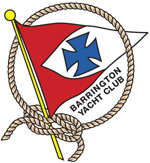
Our members enjoy a full range of services including a complete yacht Racing program for sailors of all abilities and boats of all classes, year round Social Events, and four Cruises each year to various New England ports of call.
Facilities available to our members include the club house and marina (open year-round), as well as the pool, Dana Rice building, and snack bar (open June – September). Slips and moorings are available to transient non-members for a fee, on a space available basis. Our fuel dock is available to both members and non-members.

An Active Membership
In addition to the social and racing activities, the club encourages all members to participate on various committees. The Club has a Board of Governors with standing committees such as: House Committee, Finance Committee, Race Committee, Publications Committee, Social Committee, Membership Committee, Junior Activities Committee, Sail Training Committee and Cruise Committee.
The chairs of these working committees are always interested in having new members volunteer to help out. These committees are largely responsible for the success of the club’s programs.
Making Continuous Improvements
Every year the Club invests a great deal of time and financial resources to upgrade our facility and improve our operations so that we can provide the best in services to our membership. Dock rebuilding, new boats and equipment, galley and bar upgrades are all part of the annual plan to keep our club in excellent condition.
A Rich History
The Barrington Yacht Club was incorporated on March 25, 1908. The object of the club, as stated in the bylaws, is to foster the sport of yachting and to provide suitable facilities and activities for both its social and yachting member families. For more details about the history of our club, please read the articles in the Club History section.
Junior Activities is open to children ages 9 and up who have completed 3rd grade by the summer. However, there are activities planned throughout the year for all children of BYC to enjoy including the Children’s Halloween Party, Christmas Party, Easter Egg hunt, Family Day and Little Minnows “Fun afternoons”.
During the summer the Game Room/Coach’s Room in the Dana Rice Building is open for Junior Members only. Junior Members must follow the rules (please see the Log and the Coach’s Room for a complete list of rules) and have completed the waiver for each year.



